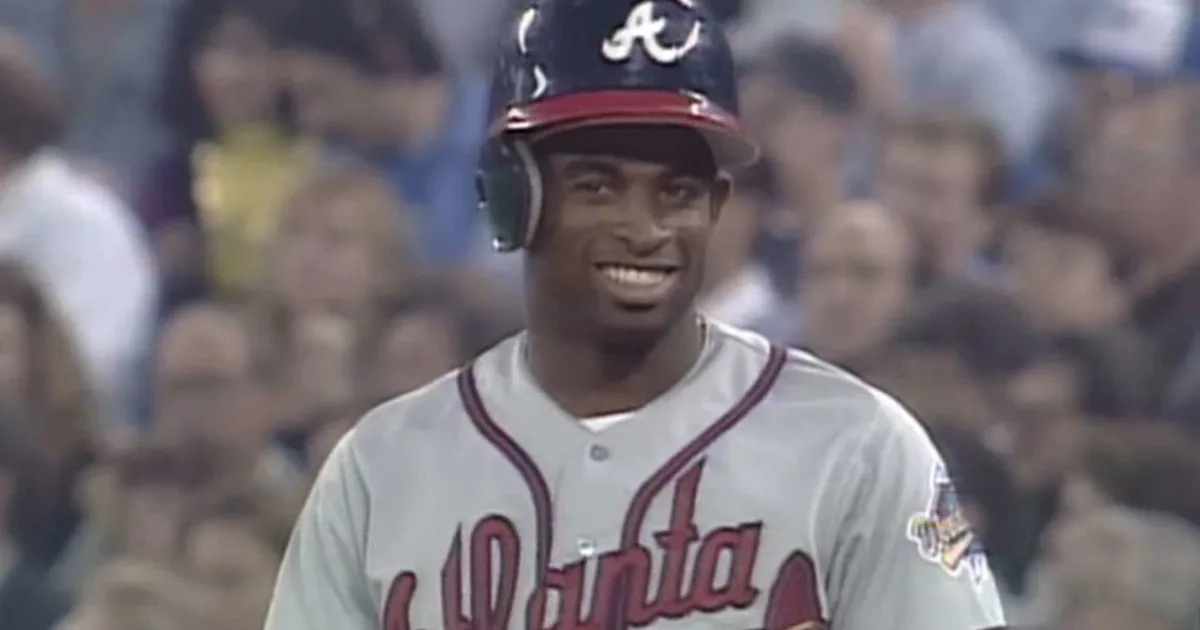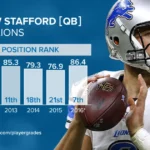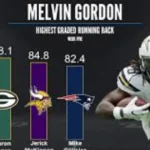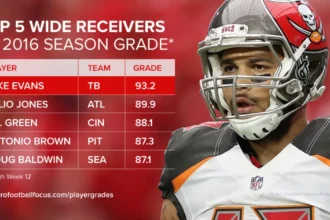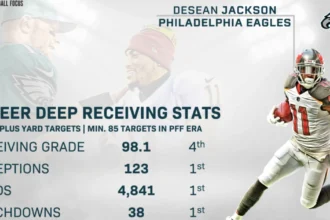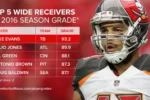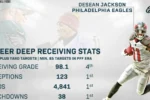Hey there, folks! If you’ve ever watched a football game and seen a player who could shut down the best wide receivers, snag interceptions like they were candy, and then zoom down the field for a touchdown while flashing that million-dollar smile, you’ve probably thought of Deion Sanders. Or as we all know him, Prime Time. Born on August 9, 1967, in Fort Myers, Florida, Deion wasn’t just an athlete—he was a phenomenon. He played in the NFL for 14 seasons, dazzled on the baseball diamond for nine years in MLB, and even turned heads in college as a three-sport star at Florida State. We’re talking about a guy who once hit a home run in a Major League Baseball game and scored an NFL touchdown in the same week. Talk about living large!
In this article, we’re diving deep into Deion Sanders’ career stats. I’ll keep it straightforward, like chatting over a backyard barbecue—no jargon overload, just the good stuff. Whether you’re a die-hard football fan, a casual baseball enthusiast, or just someone scrolling for some inspiring stories, you’ll find something here. We’ll cover his college highlights, break down his NFL numbers (with a full table to make it easy), touch on his MLB adventures, and wrap up with why Prime Time’s stats aren’t just numbers—they’re a blueprint for being unapologetically yourself. Let’s get into it!
From Small-Town Florida to Seminole Stardom: Deion Sanders Career Stats College Days
Picture this: A skinny kid from North Fort Myers High School, lettering in football, basketball, and baseball. That’s young Deion, earning All-State honors in all three sports. But when it came time for college, he chose Florida State University, turning Tallahassee into his personal playground from 1985 to 1988. Under legendary coach Bobby Bowden, Sanders wasn’t just a player; he was a highlight reel waiting to happen.
Deion played cornerback, wide receiver, and punt returner for the Seminoles, but his speed—clocking a 10.26 in the 100-meter dash—made him a nightmare for opponents. As a freshman, he was already turning heads in track, winning Metro Conference MVP honors. By his sophomore year, he racked up 61 tackles and four interceptions, earning third-team All-American nods. But 1988? That was his masterpiece. He won the Jim Thorpe Award as the nation’s top defensive back, led the country in punt return average (18.0 yards), and snagged five picks, including a game-sealing interception in the Sugar Bowl win over Auburn. Oh, and he finished eighth in Heisman voting—as a defensive back!
Stat-wise, Deion’s college career was electric. Over 45 games, he tallied 186 tackles, 14 interceptions (tied for the FSU record with four returned for touchdowns), and 126 punt returns for 1,429 yards and three scores. He also forced four fumbles and deflected passes like it was his job (spoiler: it was). On the baseball side, he hit .331 as a junior and helped FSU reach the College World Series. And don’t get me started on that infamous day in 1986 when he played a full baseball game, ran the 200-meter relay (still in his cleats), and then suited up for football practice. The Seminoles retired his No. 2 jersey in 1995, and he’s in the College Football Hall of Fame since 2011. Deion didn’t just play college sports—he redefined what it meant to be a multi-tool athlete.
Those years built the foundation for pro stardom. Drafted fifth overall by the Atlanta Falcons in 1989, Sanders was ready to take Prime Time to the big leagues. But hold up—before we hit the NFL gridiron, let’s remember he was also MLB-bound, thanks to drafts by the Kansas City Royals (1985) and New York Yankees (1988). Yeah, Deion was that guy.
Prime Time Lights Up the NFL: A Shutdown Corner with Flair
Stepping into the NFL, Deion Sanders brought more than speed—he brought swagger. Over 14 seasons (1989–2000, 2004–2005), he suited up for five teams: the Falcons (1989–1993), San Francisco 49ers (1994), Dallas Cowboys (1995–1999), Washington Redskins (2000), and Baltimore Ravens (2004–2005). He played in 188 games, starting 157, and was an eight-time Pro Bowler. His versatility? Offense (60 catches for 784 yards and 3 TDs), defense (53 INTs for 1,331 yards and 9 TDs), and special teams (a record 19 non-offensive TDs). He won two Super Bowls (XXIX with the 49ers, XXX with the Cowboys), snagged Defensive Player of the Year in 1994, and made the NFL’s All-Decade Team for the 1990s.
What made Deion special wasn’t just the stats—it was the moments. That 100-yard kickoff return TD against the Redskins in 1991? Iconic. Or his end-zone pick in Super Bowl XXIX to seal the win? Chills. Even in his 30s with the Ravens, he started all 12 games in 2004, proving age was just a number. His 25.1 yards per INT return ranks second all-time, and those 53 picks put him 22nd in NFL history. Deion wasn’t just playing football; he was performing art.
To make all this crystal clear, here’s a full table of Deion Sanders’ NFL career stats. I’ve broken it down by year and category for easy scanning—defense, returns, receiving, and scoring. (Sources like Pro-Football-Reference and NFL.com helped compile this bad boy.) Whether you’re 12 or 82, this table shows how Prime Time dominated every phase of the game.
| Year | Team | GP | GS | Tackles (Solo/Assist) | Sacks | INTs | INT Yds | INT TDs | FF | FR | Punt Ret | Punt Yds | Punt Avg | Punt TDs | Kick Ret | Kick Yds | Kick Avg | Kick TDs | Rec | Rec Yds | Rec TDs | Def TDs | Total TDs |
|---|---|---|---|---|---|---|---|---|---|---|---|---|---|---|---|---|---|---|---|---|---|---|---|
| 1989 | ATL | 16 | 0 | 0/0 | 0 | 0 | 0 | 0 | 0 | 0 | 14 | 155 | 11.1 | 0 | 27 | 555 | 20.6 | 0 | 0 | 0 | 0 | 0 | 0 |
| 1990 | ATL | 16 | 14 | 0/0 | 0 | 3 | 94 | 1 | 0 | 0 | 26 | 238 | 9.2 | 0 | 18 | 417 | 23.2 | 1 | 0 | 0 | 0 | 1 | 2 |
| 1991 | ATL | 16 | 16 | 0/0 | 0 | 7 | 179 | 3 | 0 | 0 | 17 | 112 | 6.6 | 0 | 29 | 1067 | 36.8 | 1 | 3 | 37 | 0 | 4 | 5 |
| 1992 | ATL | 11 | 11 | 0/0 | 0 | 1 | 32 | 0 | 0 | 0 | 17 | 155 | 9.1 | 0 | 7 | 144 | 20.6 | 0 | 0 | 0 | 0 | 0 | 0 |
| 1993 | ATL | 14 | 14 | 0/0 | 0 | 6 | 207 | 3 | 1 | 1 | 18 | 218 | 12.1 | 1 | 0 | 0 | 0 | 0 | 0 | 0 | 0 | 4 | 5 |
| 1994 | SF | 16 | 16 | 0/0 | 0 | 3 | 85 | 1 | 0 | 0 | 18 | 133 | 7.4 | 0 | 0 | 0 | 0 | 0 | 9 | 105 | 1 | 1 | 2 |
| 1995 | DAL | 9 | 9 | 0/0 | 0 | 2 | 30 | 0 | 0 | 0 | 11 | 104 | 9.5 | 0 | 0 | 0 | 0 | 0 | 12 | 86 | 0 | 0 | 0 |
| 1996 | DAL | 16 | 16 | 0/0 | 0 | 1 | 0 | 0 | 0 | 0 | 12 | 93 | 7.8 | 0 | 0 | 0 | 0 | 0 | 32 | 325 | 1 | 0 | 1 |
| 1997 | DAL | 16 | 16 | 0/0 | 0 | 2 | 51 | 0 | 0 | 0 | 12 | 90 | 7.5 | 0 | 0 | 0 | 0 | 0 | 7 | 74 | 1 | 0 | 1 |
| 1998 | DAL | 16 | 16 | 0/0 | 0 | 2 | 89 | 1 | 0 | 0 | 26 | 319 | 12.3 | 1 | 0 | 0 | 0 | 0 | 0 | 0 | 0 | 1 | 2 |
| 1999 | DAL | 14 | 14 | 0/0 | 0 | 2 | 27 | 0 | 0 | 0 | 21 | 202 | 9.6 | 1 | 0 | 0 | 0 | 0 | 0 | 0 | 0 | 1 | 1 |
| 2000 | WAS | 16 | 16 | 10/1 | 0 | 1 | 25 | 0 | 0 | 0 | 0 | 0 | 0 | 0 | 0 | 0 | 0 | 0 | 0 | 0 | 0 | 0 | 0 |
| 2004 | BAL | 12 | 12 | 14/2 | 0 | 1 | 22 | 0 | 0 | 1 | 0 | 0 | 0 | 0 | 0 | 0 | 0 | 0 | 0 | 0 | 0 | 0 | 0 |
| 2005 | BAL | 12 | 10 | 10/1 | 1 | 0 | 0 | 0 | 0 | 0 | 0 | 0 | 0 | 0 | 0 | 0 | 0 | 0 | 0 | 0 | 0 | 0 | 0 |
| Career | – | 188 | 157 | 34/4 | 1 | 53 | 1,331 | 9 | 1 | 13 | 212 | 2,199 | 10.4 | 3 | 155 | 3,523 | 22.7 | 3 | 60 | 784 | 3 | 19 | 22 |
(Notes: GP = Games Played, GS = Games Started, FF = Forced Fumbles, FR = Fumble Recoveries, Rec = Receptions. Tackle stats pre-1994 are incomplete as the NFL didn’t track them league-wide. Total TDs include all non-offensive scores.)
See that? Deion’s peak Falcons years (1990–1993) were pure fire—20 interceptions alone! His Dallas stint added Super Bowl glory and more return magic, like that 83-yard punt TD in 1998. By the end, with the Ravens, he was mentoring young guns while still balling out. These numbers don’t lie: Prime Time was a game-changer.
Swinging for the Fences: Deion’s MLB Magic
Hold onto your hats—because while Deion was patrolling NFL secondaries, he was also patrolling center field in Major League Baseball. From 1989 to 2001 (with gaps for football focus), Sanders played for the New York Yankees, Atlanta Braves, Cincinnati Reds, and San Francisco Giants. In 520 games, he slashed .263/.330/.394, with 558 hits, 37 home runs, 168 RBIs, and a blazing 186 stolen bases. His speed translated perfectly—stealing 56 bags in 1997 alone, second in the NL.
Deion’s MLB highlights? Hitting .533 in the 1992 World Series with the Braves (yes, he played in a World Series and two Super Bowls). Or that inside-the-park homer in 1997. He wasn’t a power hitter, but his glove (52 putouts in center) and legs made him a threat. Fun fact: In 1991, he played both an NFL game and an MLB game on the same day. Only Deion. His baseball career proved he could hang with the pros in two sports, inspiring generations to dream big.
Beyond the Box Score: Deion’s Lasting Impact
Stats are cool, but Deion Sanders Career Stats is about heart and hustle. He showed kids from tough backgrounds—like his own in Fort Myers—that you could be flashy and fierce. Off the field, he’s a dad to five (including NFL hopefuls Shedeur and Shilo), a minister, and now “Coach Prime” at Colorado, turning the Buffs around with that same energy. Inducted into the Pro Football Hall of Fame in 2011, his No. 21 jersey hangs in Canton.

